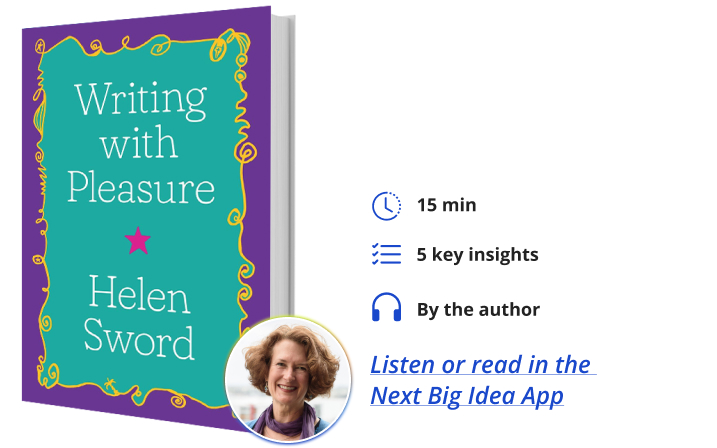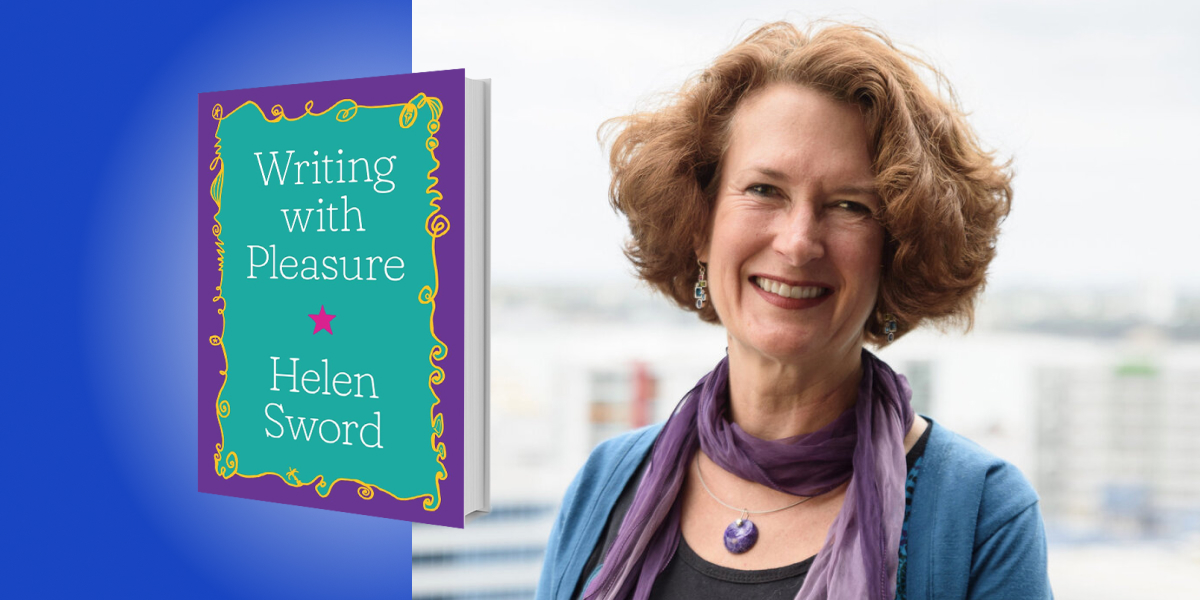Helen Sword is a writer, scholar, teacher, and poet with a Ph.D. in Comparative Literature from Princeton University. She is also a professor and Director of the Centre for Learning and Research in Higher Education at the University of Auckland in New Zealand.
Below, Helen shares 5 key insights from her new book, Writing with Pleasure. Listen to the audio version—read by Helen herself—in the Next Big Idea App.

1. Writing with pleasure is an essential professional skill that any writer can and should master.
That statement may seem counterintuitive—how can an emotion be a professional skill? How can we learn to love something we find hard or tedious or just not fun? We know from decades of research in behavioral psychology, sociology, and neuroscience that positive emotions are good for us and lead to positive outcomes in just about every possible area of life, from health and education to sports, business, finance, and relationships.
It all makes perfect sense when you think about it. If you’re the kind of writer who hates to write, you probably avoid writing like the plague and spend as little time as possible on writing assignments and meeting deadlines. If you enjoy writing and you’re intrinsically motivated to write, you’re likely to spend more time writing, write more often, and for longer stretches. You’re also willing to devote time and energy to honing your craft, which means that your writing skills get better and better. This, in turn, boosts your self-confidence so that over time you enjoy writing more and more. Psychologist Barbara Fredrickson calls this virtuous circle the “broaden-and-build” cycle of positive emotions: the more you enjoy a task, the better you’ll get at doing it, which in turn will increase your future enjoyment.
Productivity and pleasure are bedfellows, not enemies. The more pleasure you can bring to your academic or workplace writing, the more productive and prolific you’ll become.
2. Pleasurable writing looks and feels different for every writer.
There is no magic formula, no secret recipe that will work for everyone; you have to find your own path to pleasure. As part of my research, I gathered narratives of writing with pleasure from nearly 600 writers in 12 countries. What I learned, in a nutshell, is that it’s possible to find pleasure in virtually any aspect of the writing process. No two writers respond in the same way to the same writing tool or technique or process. But that’s good news because it means we can tailor our recipe for pleasurable writing to our own tastes.
“It’s possible to find pleasure in virtually any aspect of the writing process.”
Take Lis and Mark, two writers who attended my very first Writing with Pleasure workshop, which took place at a university in Yorkshire in the UK. I asked them to write for 10 minutes about a time in their life when writing gave them pleasure.
Lis, a midcareer lecturer in psychology, recalled a recent event: She’d gone with two colleagues on a writing retreat to Scotland. They rented a little seaside cottage and spent their days and evenings sitting around the dining room table typing away on their laptops, working on various academic projects. They also took lots of breaks for mutually supportive conversations about writing and for walks in the brisk sea air.
Lis’s narrative of pleasure was very different from that of Mark, a Ph.D. student in criminology. He reached way back to his childhood for his memory of pleasurable writing: when he was around eight years old. He started a project gathering wildflowers from his local surroundings, mounting them in a book, and writing about them underneath. He tried to mimic the kind of calligraphy that he’d seen in old books at the library and in bookshops.
The key differences have to do with the following: the writing was recent as opposed to during childhood; the writing was academic versus personal; the writing was done on a computer or by hand; the writing took place in the presence of others versus alone. Each of them can learn from their own story: Lis enjoyed the breaks, fresh air, and collegiality, while Mark enjoyed the materiality, solitude, and passion behind his writing. The key message here is that there are many different paths to pleasurable writing. It makes sense to walk as many of those paths as you can, because they’re all beneficial in different ways.
3. The SPACE of pleasurable writing is multi-faceted and multi-dimensional.
The acronym SPACE can help you imagine what your own space of pleasurable writing might look like. It’s a conceptual space that is: Socially balanced, Physically engaging, Aesthetically nourishing, Creatively challenging, and Emotionally uplifting.
“You can learn ways of engaging your whole body.”
Think about a pastime or hobby that you do purely for pleasure: downhill skiing, gardening, singing in a choir, making mosaics out of shards of broken crockery. Chances are that your hobby or pastime fulfills most if not all of the SPACE dimensions. Now think about the kind of writing that you do for work or school. Does it meet all of those parameters?
If any of those dimensions are missing, you can build up and round out your WriteSPACE to make it as pleasurable as possible. For example, maybe you tend to think of writing as a purely cognitive process—something that takes place just in your head. You can learn ways of engaging your whole body, attending to your writing environment, taking brainstorming walks and stretching breaks, to bring more concrete language and imagery into your writing.
4. Writing with pleasure isn’t necessarily the same thing as writing without pain.
I interviewed one hundred successful academics from across the disciplines and around the world about the main emotions that they associate with their academic writing. What they told me really surprised me. Of course, they mentioned negative emotions such as frustration, anxiety, and even pain, but the two words that came up most frequently were pleasure and enjoy. That’s when I realized the importance of cultivating pleasure in academic and workplace writing.
“Successful writers write with pleasure not because writing is easy or pain-free, but precisely because it’s hard.”
The kind of pleasure that these writers talked about isn’t a simplistic, dancing-through-the-daisies, oh-this-is-so-much-fun kind of pleasure. It’s a rich, complex, light-and-shadow pleasure, a kind of emotional chiaroscuro. Successful writers write with pleasure not because writing is easy or pain-free, but precisely because it’s hard. Their pleasure comes from the challenge of producing clear, engaging, carefully crafted prose about complex ideas.
5. When you write with pleasure, anything can happen.
Writing with pleasure is an essential professional skill; it’s also an affirmation of intellectual pleasure, creative pleasure, as a fundamental human good. When you write with pleasure, you’ll find yourself letting go, taking risks, thinking more expansively, writing more fluidly and imaginatively, and—here’s the icing on the cake—living more joyfully. What’s more, in doing so, you’ll be bringing your readers pleasure as well. And what could be better than that?
To listen to the audio version read by author Helen Sword, download the Next Big Idea App today:






























